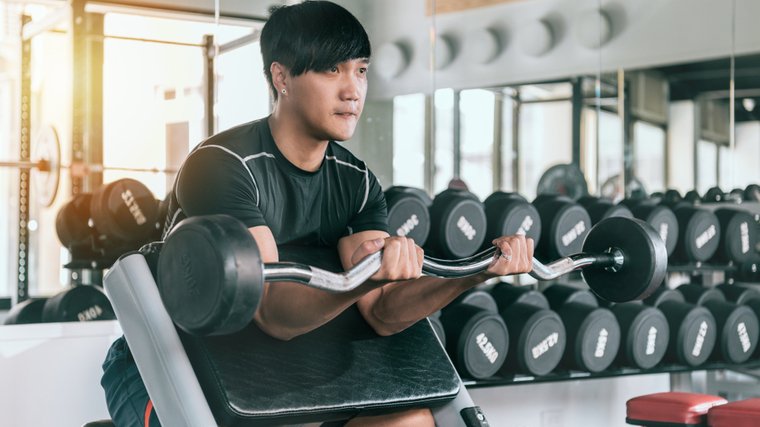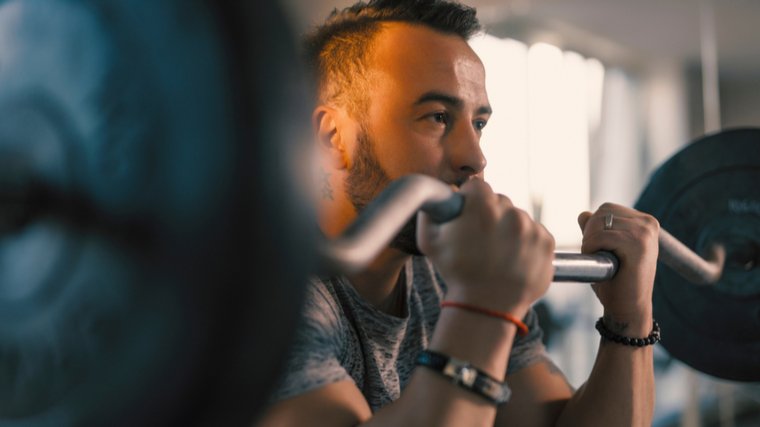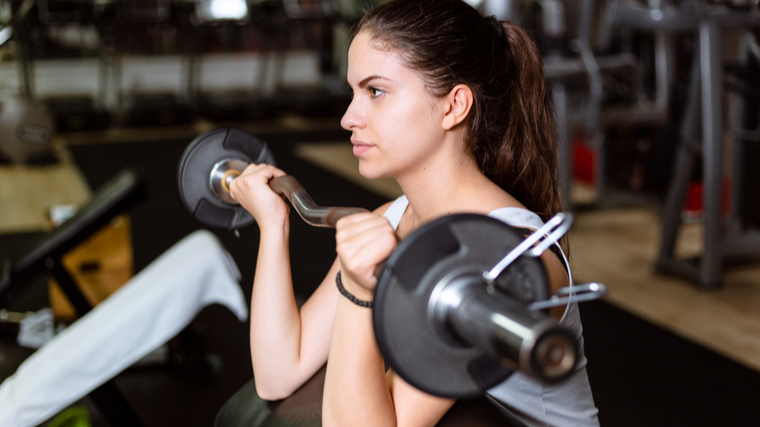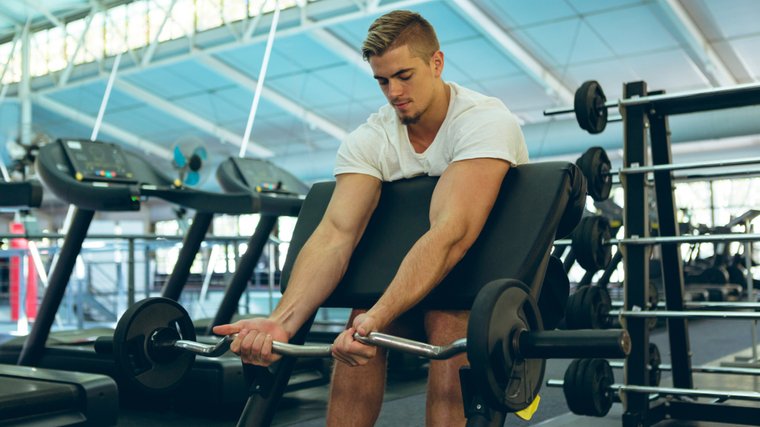Learn the Preacher Curl to Build Strong and Inspiring Biceps
Stroll into your gym any day of the week and you’re bound to see at least one person in a cut-off muscle tank doing some kind of biceps curl. The traditional biceps curl is a rite of passage in the gym — even if you’re the jerk doing them in the squat rack (pro tip: don’t be that jerk).
If you’re a newbie, you probably want to start building those biceps, perhaps to Hulk-esque proportions. And if you’re more advanced, you know that there’s nothing quite like feeling your biceps swell rep after rep. This is where the humble but mighty preacher curl comes in.

It may not look as sexy as its biceps curl cousins, but the preacher curl forces even more isolation to your biceps. That’s a recipe for max gains. You’ll sit down and put your upper arms on an angled pad to isolate your biceps and forearms to a greater degree than other curl variations. Here, you’ll learn how to get the most out of this move to watch your biceps pump with pride.
- How to Do the Preacher Curl
- Preacher Curl Sets and Reps
- Common Preacher Curl Mistakes
- Preacher Curl Variations
- Preacher Curl Alternatives
- Muscles Worked by the Preacher Curl
- Benefits of the Preacher Curl
- Who Should Do the Preacher Curl
- Frequently Asked Questions
How to Do the Preacher Curl
Learning how to perform a proper preacher curl is essential when you’re looking to maximize biceps and forearm recruitment. Traditionally, this move will be done with a curl bar, which is what this step-by-step guide focuses on.
Step 1 — Set Up

Sit down on the preacher curl bench. Adjust the seat height so your upper arms and chest are in contact with the pad. Grip the curl bar with an underhand grip.
Coach’s tip: If this position aggravates your shoulders, try gripping the bar tighter. This can provide more shoulder stability. Otherwise, try performing a variation or alternative exercise.
Step 2 — Curl

Tuck your chin. Fully extend your elbows. Maintain a neutral wrist position with your preferred grip. Curl the bar by contracting your biceps while bending your elbows. Lift the curl bar to your shoulders. Finish by squeezing your biceps.
Coach’s Tip: Drive the backs of your upper arms into the bench pad while you’re contracting your biceps to avoid lifting with momentum.
Step 3 — Lower Under Control

Slowly straighten your elbows to lower the curl bar to the starting position. Reset and repeat.
Coach’s tip: Avoid letting momentum take over. If you feel like you can’t control the descent, use lighter weight.
Preacher Curl Sets and Reps
Assuming your shoulders are not uncomfortable on the preacher curl pad, you can use this exercise to build muscle, develop endurance, and add some serious grip strength to your arm training. Go a little lighter until you get used to performing curls on a pad. When you do get the chance to advance the load, remember that this is not an all-out strength exercise. That said, you can still use it to supplement big strength gains.
- For Muscle Mass: Perform three to four sets of 8 to 12 reps with moderately heavy weight, going to technical failure.
- For Endurance: Do two to three sets of 15 to 20 reps using shortened rest periods and lighter weight.
Common Preacher Curl Mistakes
You’re just performing a biceps curl — how hard could it be? Well, there are a few things you should watch out for when performing the preacher curl.
Treating it Like a Strength Exercise
This is not an exercise that you’re going to load up to a one-rep max. Instead, this is a single-joint accessory move meant to isolate your biceps for growth. Going too heavy compromises your form — for example, your upper arms leaving the pad while you use too much body English to yank up the weight. That can put your anterior delts at risk. Keep the lights only moderately heavy instead of ramping it all the way up.
Small Range of Motion
Fully extending and flexing your elbows to go through a full range of motion — and adding that squeeze at the top — will promote a better biceps curl. When you don’t extend your elbows down well past 90 degrees, you’re cheating yourself out of the full range of muscle-building potential this lift has to offer. And when you don’t squeeze at the top, you’re missing out on the benefits of a full muscle contraction with each rep.
Incorrect Set-Up
Take the time to adjust the bench and your body position. Make sure your chest and upper arms are against the pad on their respective sides, with your underarms snug over it. Being too low or too high will put you out of position before you even pick up the weight.
Sitting too high up will require you to hunch over the pad, potentially preventing you from reaching a peak contraction at the top of the lift. On the other hand, not being high enough up won’t let you fully extend your elbows. Either extreme runs the risk of aggravating your shoulders, as you may be displacing stress from your biceps muscles onto your shoulder joints.
Preacher Curl Variations
If you’ve got a preacher bench but want to add some extra spice to your biceps routine, check out these variations for the next time you get your flex on.
Close-Grip Preacher Curls
For this variation, you’ll use the same setup as the regular preacher curl. Except this time, you’ll adopt a narrow grip. Your biceps muscles have two heads — the long and the short head — and by changing the width of your grip, you can emphasize one of the other.
A wide grip emphasizes the short head, while a narrower grip will focus on the long head. Mix and match your grip strategy to stimulate fuller muscle development.
Dumbbell Preacher Curls
Dumbbell preacher curls give you a few more options than the barbell variety. You can train unilaterally to strengthen imbalances between sides. By using a dumbbell, you’ll prevent your dominant arm from inadvertently taking over the exercise. In doing so, that’ll let you ensure more even muscle development.
Dumbbells also offer you more freedom of movement because you can alter your grip to be overhand, underhand, or neutral. Doing so gives you even more control over the muscles you’re isolating in terms of your forearms and the two heads of your biceps.
Preacher Curl Alternatives
If you don’t have access to a preacher curl bench or machine — or you just want to mix things up— these preacher curl alternatives provide other great ways to make your biceps nice and swole.
Incline Biceps Curl
This one is probably the toughest dumbbell biceps exercise around. Sitting on an incline puts an incredible stretch on your biceps and gives you a much bigger range of motion.
When you’ve got a bigger range of motion, you’ve generally got even more muscle-building potential. You’ll still get a similar benefit of the preacher curl, where you’re stabilizing your body against a surface to minimize torso swing and increase biceps isolation.
Concentration Curl
Just as you want when you’re looking for the maximum pump, all the focus here will be on your biceps. Since your upper arm position is fixed as in the preacher curl — though this time, it’ll be on the inside of your knee — you’ll be better able to isolate your biceps for a better pump.
Since you’ll do this move with dumbbells, you’ll be able to combat side-to-side strength imbalances. Say goodbye to one sleeve popping more than the other.
Wall Biceps Curl
The trick with the wall biceps curl is to minimize any momentum from your upper back so all the focus is all on your biceps. Keep your head, upper, and lower back against the wall at all times.
Squeeze your glutes during this move to resist the temptation to hyperextend your lower back with all the effort.
Muscles Worked by the Preacher Curl
The preacher curl setup makes this biceps curl variation a great isolation exercise for your biceps. And that’s a bigger selling point than it seems, because it’s pretty darn hard to isolate your biceps. Fixing your upper body and arms to the bench and sitting down drives more engagement where you need it most — those biceps, baby.
Biceps
These are the main movers for the preacher curl. Your hand placement will affect which biceps head is more targeted. The normal-to-wide grip trains the short head of your biceps, while a narrow grip puts more emphasis on the long head. Mix and match to build your biceps peak.
Forearms
Your forearms pull double duty when it comes to any curl variation. Your forearms are isometrically supporting your grip by helping hold your wrist neutral. They’re also involved every time you extend and flex your biceps. As your forearm is predominately made up of slow-twitch muscle fibers, you need more time under tension to grow this difficult muscle group. Slow preacher curls can help with that.
Benefits of the Preacher Curl
It’s not all about having big biceps and muscular forearms — although, there’s that, too.
Beefier Biceps
Because you’re sitting down and your upper body and arms are fixed, your biceps work harder to perform the curl movement than a lot of other biceps curl variations. The only way you’ll cheat yourself here is not fully extending your elbows or rocking back and forth to curl the bar. As a result, it’s a lot easier to focus on nothing but the weight and feeling that burn.
The more high-quality biceps isolation training you can get in, the better your biceps growth can be. Slow the preacher curl down — especially in the eccentric (lowering) portion — for an added boost to your forearms.
Help Out With Compound Exercises
Your biceps may not be the primary movers, but they certainly still play a role in exercises like rows, chin-ups, and pull-ups. They’re also the secret helpers behind pull-oriented moves for your shoulders, upper back, and lats.

Isn’t it a shame when your biceps give out before you’ve maxed out your back and shoulders? You’re only as strong as your weakest link — having stronger biceps will only help when it comes to building a strong and muscular back.
Better Shoulder Stability
The biceps are a double-headed muscle, which attaches to your scapula and shoulder joint. In that capacity, your biceps has a role in helping your rotator cuff with shoulder stability, particularly through your anterior deltoid.
Picture it this way: your rotator cuff secures your humerus to your shoulder joint. Your biceps secure your shoulder joint to your humerus. This compression from both sides benefits your shoulder stability. Strengthening your biceps with preacher curls can help improve this stability.
Who Should Do the Preacher Curl
Regardless of your training goals or experience level, you can probably find a place for the preacher curl in your program.
Strength Athletes
Strength athletes like powerlifters and weightlifters can train preacher curls for more than just muscle hypertrophy. Weightlifters, powerlifters, and strongman athletes all rely on biceps strength to assist with deadlifting and pulling performances — think deadlifts, cleans, snatches, and picking up heavy stones. So, it pays in your performance — not to mention your shirt sleeves — to train your biceps with preacher curls.
Bodybuilders
Any bodybuilder worth their salt spends time training their biceps for their front double biceps pose. Isolating your biceps with the preacher curl using the wide and close grip to train both heads will go a long way toward getting your biceps popping when you’re getting ready for a show.
Beginners and Recreational Lifters
For a lot of beginners and recreational lifters, biceps curls are an exercise that they see a lot of people performing. It’s easy to try and swing through your own curls — but in doing so, beginners might use a bit too much body English without their bodies knowing proper form.

Then, there’s the temptation to go too heavy, too fast. The preacher curl helps stem both temptations. With the lifter sitting down and their upper body and arms locked in, the preacher curl returns the focus to the biceps rather than kipping too much weight all around.
Preach
If you’ve been looking far and wide for bulging biceps, the preacher curl might just be the lift you didn’t know you needed. It’ll keep your body strict about form by holding down your chest and bracing your upper arms. That takes care of any unwanted momentum or form imperfections that can result in less-than-ideal results. Add the preacher curl to your repertoire when you want your form to check itself — and to pack some serious size onto your flex muscles.
FAQs
The preacher curl is a simple movement, but it does require some setup and attention to form. Below are some of the most common questions we get regarding the preacher curl.
Is the preacher curl better than standing curls?
All things being equal, there is no better or worse exercise — only different. It just depends on your goals. If your goal is to move more weight and to practice keeping your core stable while manipulating loads, then opt for standing curls. But if your goal is bigger biceps, the increased stability of sitting down for the preacher curl makes it a great bet.
What if the preacher curl hurts my shoulders?
You’ll perform this move with the preacher curl bench pad wedged under your underarms. This forward flexed position might cause discomfort for your front delts. If it does, consider checking in with a medical provider to get clearance for these kinds of exercises and address any underlying issues. You might also want to opt for an alternative to the lift, like concentration curls.
Can you use a barbell instead of a curl bar?
Yes. You may be able to load the barbell variation heavier, but barbells are very unforgiving, as they lock you into a fixed range of motion. Your wrists, shoulders, and elbows might not love performing this move with a barbell, since you’re already fixing your range of motion. In that case, it’s better to stick with the dumbbell or curl bar variations.
Is the preacher machine better than the free weight variations?
The cable machine preacher curl provides constant tension throughout the range of motion, as opposed to the free-weight version. The constant tension is slightly better for hypertrophy. But keep in mind that you have more control with the loading of the free weight variations. You might also not have access to the machine variation — but you can rig a dumbbell preacher curl bench by using an incline bench if need be.
{"@context":"https://schema.org","@type":"FAQPage","mainEntity":[{"@type":"Question","name":"Is the preacher cu
Deja una respuesta

►Te puede interesar...